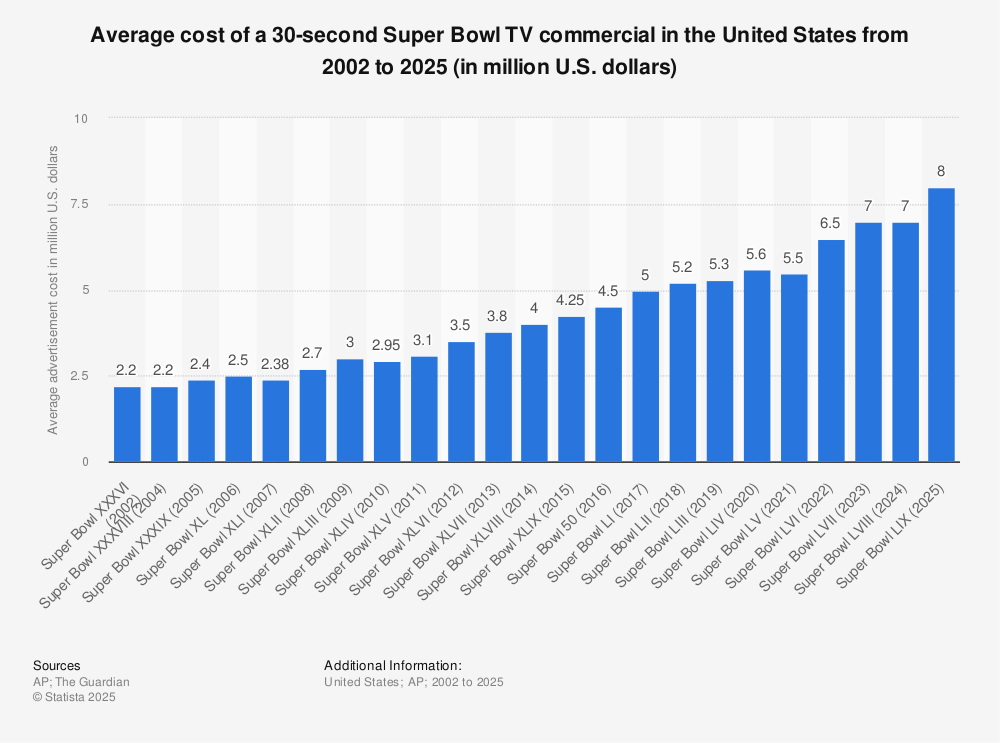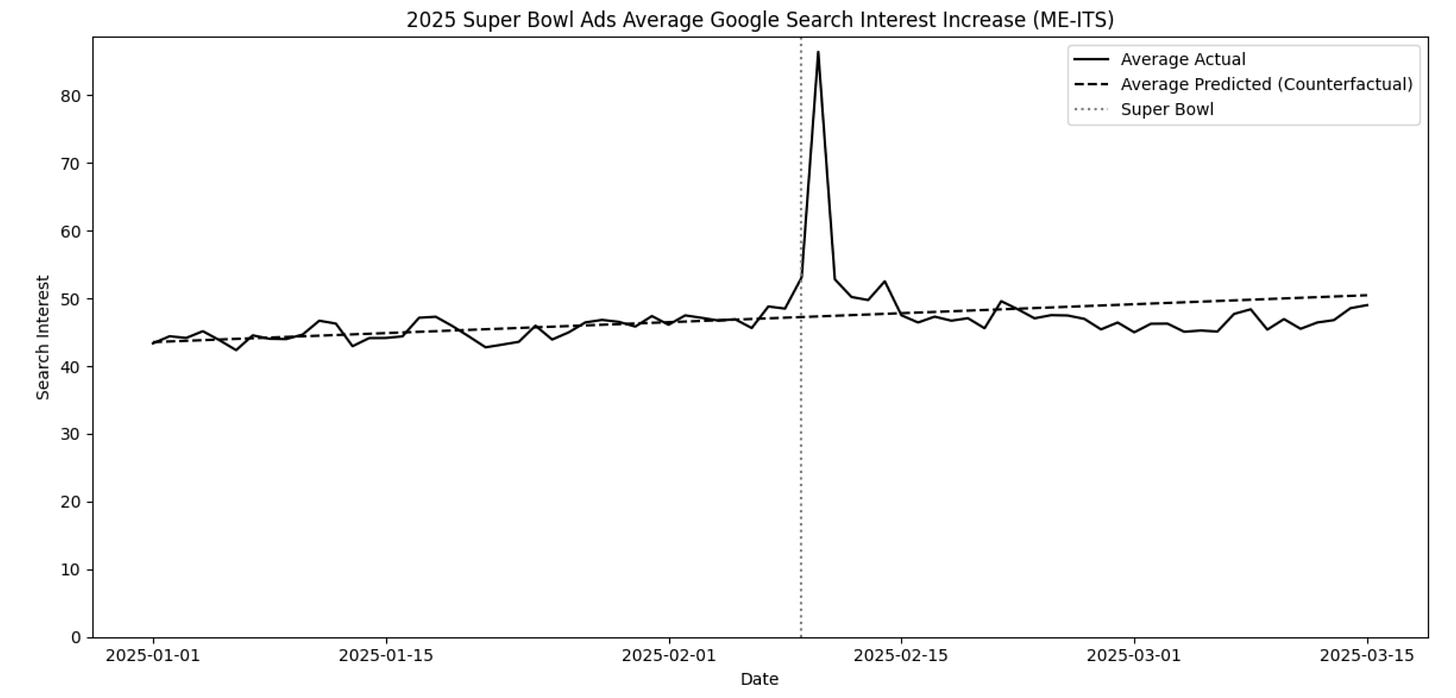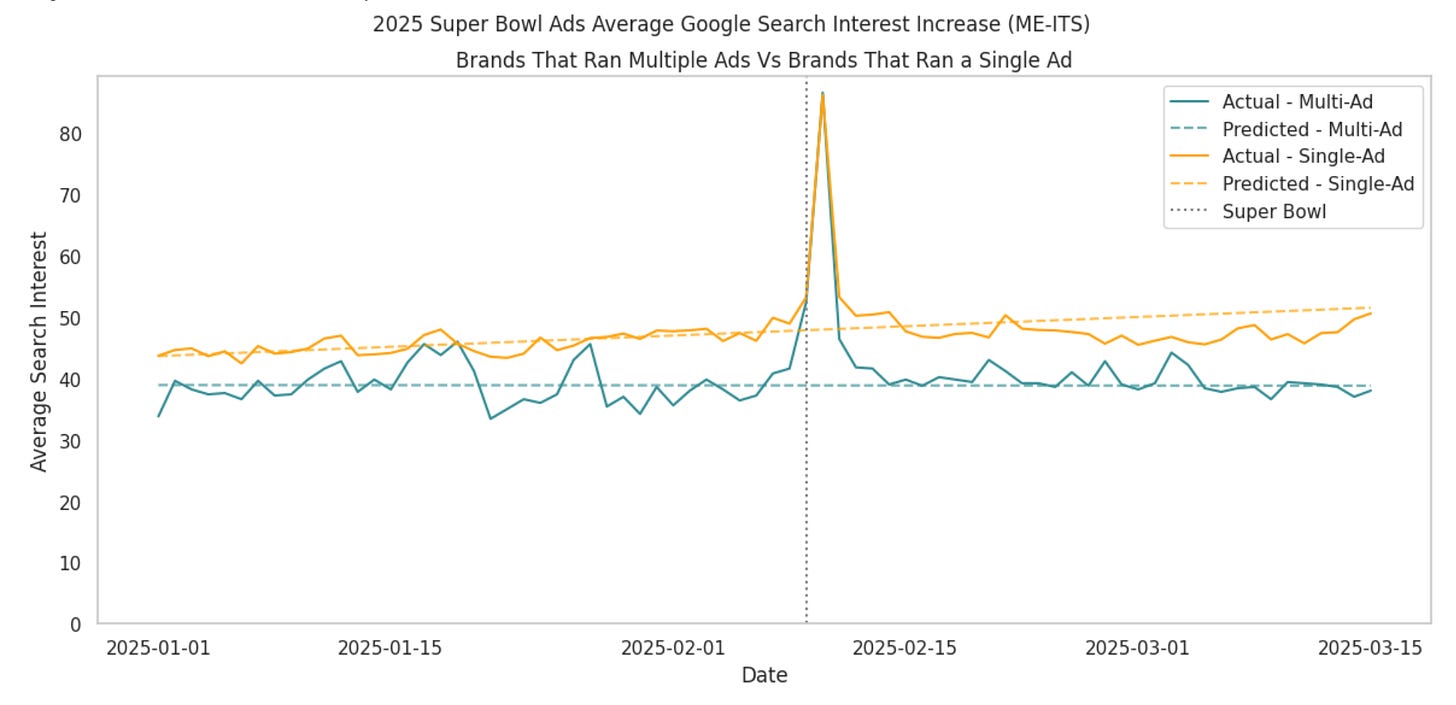The $7 Million Question: Are Super Bowl Ads Worth It?
What the data says about the most expensive ads on earth.
The 2025 NFL season is underway, and it’s got me, like many marketers, thinking about the Super Bowl.
If you’ve ever worked at a big company with a big marketing budget, you’ve probably been in the room when someone said it:
“What if we did a Super Bowl ad?”
The reach is unmatched. Not only do millions of people watch the Super Bowl, they actually look forward to the ads. It’s one of the rare moments in modern media where people don’t skip the commercials; they discuss them, rank them, and share them for days afterward.
But they’re also incredibly expensive.
So the real question is: Are they worth it?
How Do Super Bowl Ads Work?
Super Bowl ads aren’t just flashy one-offs that get slapped together a week before kickoff. They’re massive, multi-million-dollar investments planned almost a year in advance.
From how early the slots get bought to how much the total campaign can cost (hint: way more than the sticker price), there’s a whole playbook behind what you see on game day.
Here’s how it all works, starting with who gets to buy a spot and when.
When Do Super Bowl Ads Get Bought?
Super Bowl ad slots start getting reserved almost a year in advance. Legacy advertisers (like Budweiser and Doritos) are typically given first dibs in March, right after the previous season ends, before remaining inventory is offered to new buyers.1
For the last two years, Super Bowl ad slots had sold out by November (for the following February).23 But this year, rumors suggest NBC sold out Super Bowl 2026 as early as June, prompting them to request additional slots from the NFL. Any remaining inventory is reportedly now selling for as much as $8 million for a 30 second slot, up from $7 million before the initial sellout.4
How Much Do Super Bowl Ads Cost?
A 30-second Super Bowl ad will cost you $7–8 million in 2025.
To put that in perspective:
That’s $233,000 per second, making Super Bowl ads the most expensive commercials on Earth.
Here’s how Super Bowl ad pricing has trended over the last couple of decades.

And that’s just for the airtime, not including production, celebrity talent, social campaigns, or media amplification.
Plus, some companies buy longer or multiple spots, and advertisers are often required to “match” their Super Bowl media buying with more advertising on the same network throughout the year.5 6
All in, a full 2026 Super Bowl campaign could easily cost $26–45 million or more.7
🔗 Click here to open the table in a new tab.
So, is it all worth it?
We can’t know for sure whether a Super Bowl ad “paid off” without access to a brand’s internal sales data or customer LTV. Most companies don’t run Super Bowl ads for short-term conversions; they do it to build their brand.
But while we can’t see incremental revenue, we can observe whether the ad worked in a more fundamental way: did it get people interested in the brand?
How Do Super Bowl Ads Affect Brand Interest?
To quantify the real impact of Super Bowl ads, I analyzed changes in Google search interest using Google Trends for every brand that ran a commercial during the 2025 game.
Search interest provides a fast, behavior-based signal of attention: when people are curious about a brand, they tend to Google it. That makes Google Trends a powerful proxy for measuring top-of-funnel lift, especially in the hours and days immediately following a high-profile ad.
Unlike surveys or self-reported metrics, Google Trends reflects what people actually do in the moments after seeing an ad, regardless of where they saw it (TV, YouTube, streaming, TikTok). It’s immediate, public, and reproducible, and research has shown it to be correlated with positive brand attitudes.89
🔎 Across 60 brands that ran Super Bowl ads in 2025, there was a 112% average increase in Google search interest following the game.
This lift was calculated using a mixed-effects interrupted time series model, which estimates the counterfactual search trend had the Super Bowl ad not been aired. The sharp divergence between predicted and actual interest highlights the powerful (if short-lived) attention boost these ads deliver.
But there’s an important caveat: after the spike, the actual trend dips below the predicted baseline. This suggests that the ad may have pulled some demand forward, driving people to search earlier than they otherwise would have, rather than generating entirely new interest. In other words, some of that spike may be borrowed attention, not purely additive.
🔎 Ads with celebrities don’t reliably outperform ads without them, so they may not be worth the added cost.
I watched each Super Bowl and categorized them based on whether they included celebrities, like actors, sports stars, and influencers. (Notably, Matthew McConaughey was featured in two separate commercials: Salesforce and Uber Eats!) When comparing Super Bowl ads with and without celebrities, the celebrity ads showed a slightly lower search lift (-9.6%). But given the high p-value (0.47), we can at least conclude that ads featuring celebrities perform about the same as ads without, despite often costing much more to produce.
🔎 Running multiple Super Bowl ads may drive incremental increases in search interest.
Brands that ran multiple Super Bowl ads experienced a +47.8% higher increase in search interest (117.9% versus 79.8% for single-ad brands).
The caveat? Only a handful of brands ran multiple spots (n = 4), so there may be confounders at play. The difference (p = 0.114) wasn’t statistically significant, possibly due to the small number of multi-ad brands, but the directional signal is clear: saturating the airwaves may pay off in terms of attention.
🔎 The biggest search interest lifts came from lesser-known or emerging brands whose ads introduced them to a national audience.
Some brands saw massive gains in Google search interest following their 2025 Super Bowl ads, indicating clear signals of breakout attention.
Here are the standouts:
He Gets Us topped the list with a staggering +2,855% increase (nearly 30X!)
He Gets Us leaned into consistency and contrast. Riding its third Super Bowl in a row, the “What Is Greatness?” spot used familiar visuals (still photo-style montages, somber black backdrops) to create a sense of solemnity and gravitas. The execution pivots away from spectacle and instead invites reflection: what does “greatness” really mean, especially when set against cultural definitions of power, status, or success? This year’s spot reframed “greatness” through everyday acts of humility and kindness. It didn’t preach or polarize; instead, it focused on an inclusive, human message, which is likely what made it resonate.
Thunderbolts and Fetch App followed closely, with lifts of +1,989% and +1,879% respectively, catapulting both from near-zero awareness to national recognition.
Fetch’s ad was all about the benefit, and it was cleverly built to drive action. A $10K giveaway framed the story, clearly signaling that Fetch is a rewards app. Then, it encouraged viewers to download the app for a chance to win, moving them directly into their marketing funnel. While AdWeek dismissed the spot as unoriginal,10 that critique misses the point: this wasn’t about chasing vanity ad industry awards. It was about performance. Fetch didn’t rely on celebrities or cinematic flair; they focused on clear messaging, a strong incentive, and a call to action that actually turns viewers into users.
Cirkul and Liquid Death delivered similarly explosive gains of +976% and +955%, proving the power of unconventional creative and curiosity-driven branding.
Liquid Death’s ad looked like a gritty beer commercial, complete with a grungy jingle and a montage of workers (like surgeons and pilots) cracking open cold ones on the job. The twist? They’re all drinking Liquid Death water and iced tea. It’s a clever play on perception. The brand has always packaged water to look like beer, appealing to people who want to fit in without actually drinking alcohol. This ad doubled down on that premise, using workplace settings to subvert expectations and reinforce their identity as the rebel brand for sober-curious drinkers.
Tubi’s ad sparked a +612% lift, while Michelob ULTRA and Totino’s saw spikes of +475% and +443%, respectively.
Michelob ULTRA’s ad was built around a clear, clever concept: hustling unsuspecting pickleball players to win their Michelob ULTRAs. It tapped into trending culture with the rise of pickleball and added a clever twist by casting Old Hollywood legends who outplay modern pros. The celebrity cameos added charm, but the story stood on its own: fun, easy to follow, and rooted in the product.
🔎 Some major brands saw little or no lift, suggesting their ads weren’t able to break through the noise.
Not every Super Bowl ad got people Googling. A few well-known brands saw only modest lifts. Booking.com (+10%), Bosch (+11%), Instacart (+14%), and Rocket (+20.1%) nudged upward, but paled in comparison to the massive surges seen by lesser-known brands.
Rocket’s ad made history as the first Super Bowl spot to sync with a live sing-along in the stadium. While the moment was cute and fun to discuss afterward, it likely left first-time viewers confused and did little to reinforce Rocket’s core message as an accessible mortgage provider.
These modest gains suggest that for established players, generating new interest is hard, especially if the creative doesn’t surprise or provoke. If your brand is already broadly familiar, you need to work even harder to get people curious.
Notably, high-profile brands like TurboTax, GoDaddy, and ChatGPT saw no statistically significant lift, suggesting that their ads, while visible, didn’t drive meaningful top-of-funnel behavior.
ChatGPT’s ad was surprisingly underwhelming. While it traced major milestones in human innovation, like fire and space travel, the tone felt more cerebral than emotional. It lacked the punch and memorability that typically define standout Super Bowl ads, and the results seem to reflect that.
This ad, which they recently posted on YouTube, is a step in the right direction, though it’s probably still too subtle for the Super Bowl.
How to Maximize Super Bowl Ad Effectiveness
If you’re considering a Super Bowl spot, here’s what to keep in mind:
Fame favors the bold. The brands that stood out (like Liquid Death, Michelob Ultra, and He Gets Us) leaned into distinct concepts that communicated their brand promise clearly and memorably. Whether it was humor, surprise, cultural relevance, or emotional resonance, each one delivered a message that was both easy to grasp and hard to forget. In a crowded Super Bowl lineup, clarity and commitment go further than cleverness alone.
You may not need to spend on celebrities. Star power can generate buzz, but it’s not the only way to win the game. Ads featuring celebrities did not clearly outperform those without. And some of the most effective Super Bowl ads came from brands with bold creative, clear positioning, or unexpected humor, no A-listers required. If your concept is strong and strategically grounded, it can outperform spots with bigger budgets featuring famous faces.
Your pregame and postgame strategy is crucial. A $7 million ad slot is just the start. Search interest tends to spike and fade quickly—often returning to baseline within days—so you need a plan that stretches beyond the 30 seconds on air. The most effective brands treat their Super Bowl spot as a launchpad, not a one-off. That means teasing the ad beforehand to build anticipation, owning the conversation during the game, and following up with social, PR, and performance campaigns that extend the moment. Fetch nailed this by immediately pulling viewers into their funnel with a $10K giveaway that required downloading the app.
Measure the right things. Search interest is one signal. Pair that with sentiment analysis, web traffic, and sales lift to see the full picture and maximize your learning for future optimization.
Super Bowl ads are insanely expensive and tough to nail, but there’s no denying they can drive massive brand awareness when done right. The key is being able to turn that attention into revenue.
To endless possibilities,
Casandra
Premium Bonus: Complete Super Bowl Ad List With Search Interest Results
Want to dig into the numbers yourself? I’ve included the full breakdown of search lift by brand below, including columns to indicate which brands feature celebrities in their ads, and which brands ran multiple ads. Use it to explore your own hypotheses, benchmark brand performance, or run your own analysis. (If I had more time, I would look at performance by ad length and performance by brand category next!)





